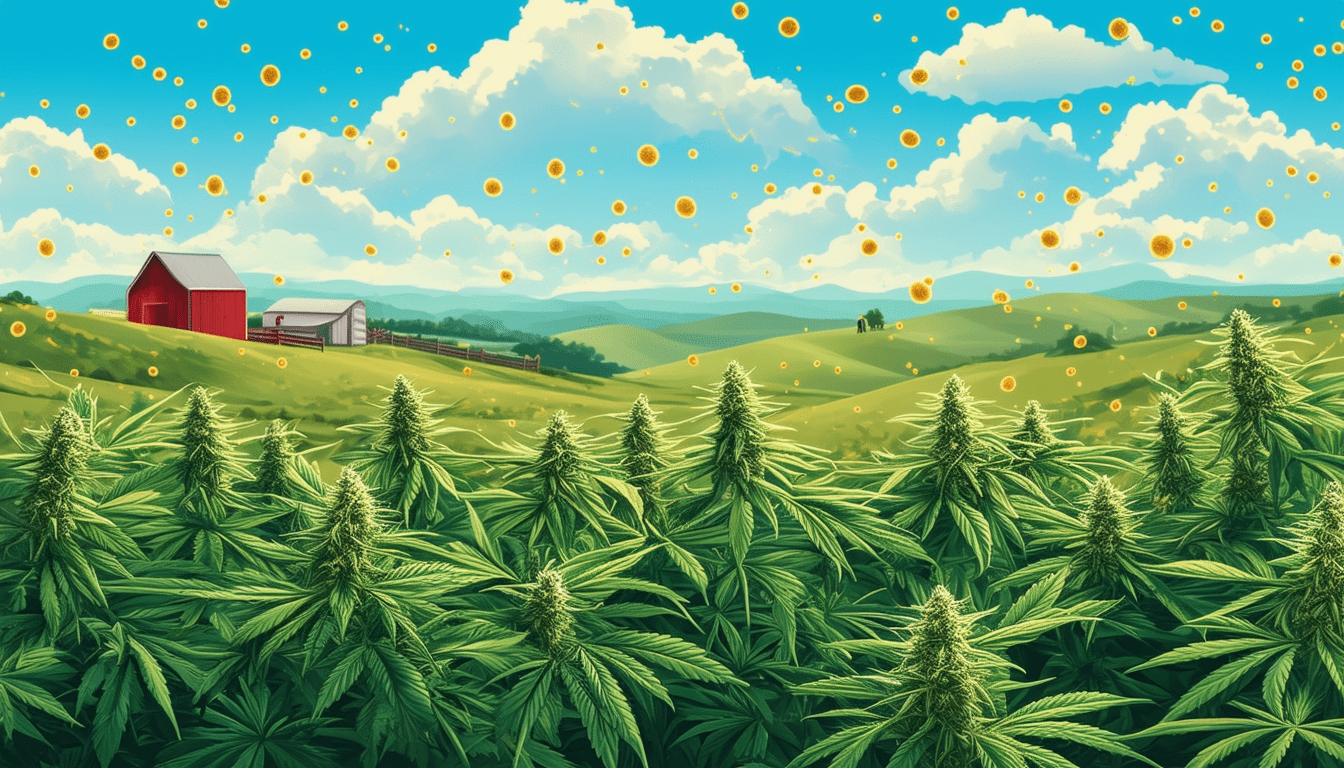Study Reveals Cannabis Pollen’s Extensive Wind Journey, Sparking Concerns Over Hemp Crop Cross-Pollination
|
IN BRIEF
|
Recent research has highlighted the troubling dynamics of cannabis pollen dispersion, revealing how far and wide these minuscule particles can travel on the wind. The study emphasizes that the potential for cross-pollination between marijuana and hemp crops is not merely a theoretical concern but a real and pressing issue for farmers across the United States. As pollen dispersal rates significantly increase during the seasonal transition from summer to autumn, the implications for agricultural practices, particularly in hemp cultivation, warrant serious attention. This raises crucial questions about the risks associated with hybridization and crop contamination, ultimately impacting the livelihood of those involved in the hemp industry.

A recent study published in Scientific Reports has highlighted the extensive journey of cannabis pollen, raising significant concerns about its impact on nearby hemp crops. The research identifies how seasonal and environmental factors contribute to pollen dispersion, which increases the risks of cross-pollination. As cannabis pollen travels further during the day, hemp cultivators face potential crop contamination, leading to challenges in achieving desired traits and compliance with federal standards.
Pollen Dispersion Dynamics
The study found that cannabis pollen dispersal rates tend to escalate from summer to autumn, meaning the risk of cross-pollination heightens during this period. The researchers observed that daytime conditions allow pollen to travel farther due to reduced atmospheric stability, facilitating wider dispersal. This diurnal variation can drastically affect hemp crops, particularly those cultivated near marijuana fields.
The Impact of Cross-Pollination
Cross-pollination poses a formidable challenge for hemp farmers, leading to contaminated seeds and reduced oil yields. The study emphasizes that mixing hemp with nearby marijuana can cause THC levels to exceed federally mandated limits. This scenario jeopardizes not only crop integrity but also the livelihoods of farmers who depend on maintaining specific strain qualities for market success.
Methodology of the Study
Utilizing a sophisticated modeling approach, the research team from Virginia Tech analyzed wind-borne hemp dispersion across the contiguous United States. By incorporating meteorological data, they simulated the travel of pollen through a comprehensive array of over 31,000 scenarios. This data-driven model provides critical insights for understanding pollen dynamics on a county-by-county basis, applying localized weather patterns to assess risk levels more effectively.
Recommendations for Hemp Farmers
The findings from the study advocate for more adaptive risk management strategies among hemp growers. Given the variability in pollen dispersion across different seasons and regional contexts, strict isolation distances may not suffice to prevent cross-pollination. The authors suggest incorporating community planning efforts, encouraging dialogue among farmers to coordinate crop choices, and possibly introducing measures like intertemporal zoning or cross-pollination damage insurance.
Government Involvement and Policy Shifts
The growing concerns regarding cannabis pollen dispersion have garnered attention from policymakers, particularly as hemp production has surged following the legalization of hemp via the 2018 Farm Bill. Recent adjustments to federal crop insurance programs reflect a shift in recognizing hemp as a viable agricultural commodity rather than an illegal crop. Such changes indicate a momentum towards sustainable hemp farming practices that may help mitigate contamination risks.
Future Research Directions
While this study sheds light on cannabis pollen dynamics, the authors emphasize the necessity of further research to understand the physics of pollen dispersal better. This understanding is crucial in developing robust strategies to protect hemp crops from unintended contamination. The methodologies employed in this study can potentially be applied to other crops susceptible to wind-borne pollen, expanding the scope of agricultural risk management.
For more information on the challenges and benefits of hemp farming, refer to articles on hemp farming and CBD industry growth.
Comparative Analysis of Cannabis Pollen Dispersion and Its Impact on Hemp
| Key Factors | Details |
| Pollen Dispersal Seasonality | Pollen dispersal rates increase from summer to autumn. |
| Daytime Dispersion | Pollen tends to travel further during the day, facilitated by wind conditions. |
| Source of Pollen | Cannabis plants, particularly hemp, produce lightweight pollen capable of extensive travel. |
| Risk of Cross-Pollination | Proximity of hemp and marijuana crops elevates the chance of unintended hybridization. |
| Consequences of Contamination | Can lead to seed contamination, reduced oil yields, and potential crop destruction. |
| Meteorological Influence | Regional weather patterns significantly affect pollen dispersion dynamics. |
| Adaptive Management Strategies | Farmers are encouraged to adopt flexible strategies to mitigate cross-pollination risks. |
| Implications for Policymakers | Research findings aim to better inform regulations affecting hemp farmers and crop management. |

A recent study has unveiled the significant reach of cannabis pollen, illustrating the complexities surrounding its dispersement and the inherent risks of cross-pollination for hemp crops. As pollen dispersal rates increase from summer to autumn, the findings are crucial for hemp growers who need to comprehend the implications of nearby marijuana crops on their yields and crop quality.
The Dynamics of Pollen Dispersal
According to the research published in Scientific Reports, the movement of cannabis pollen is influenced by a variety of seasonal and environmental conditions. Notably, the study identifies that pollen travels further from its source during daytime, which raises pressing concerns for hemp farmers situated close to marijuana fields. The comprehensive data analysis utilized meteorological modeling to simulate wind-borne pollen distribution across the contiguous United States.
Factors Contributing to Cross-Pollination Risks
The ramifications of cross-pollination are severe, potentially leading to contaminated seeds and reduced crop yields. One of the primary issues arises when hemp crops unintentionally mix with marijuana pollen, resulting in elevated THC levels that may exceed federal regulations. This situation poses significant challenges for farmers aiming to maintain specific crop traits designed for optimal production and market compliance.
A Pioneering Investigation
This study marks a pioneering initiative to elucidate the risks associated with windborne hemp cross-pollination. The authors, affiliated with Virginia Tech, emphasized the variability of these risks across geographic regions and seasonal changes. Their model included over 31,000 simulations, mapping pollen dispersion to identify high-risk areas, thereby assisting farmers and policymakers in making informed decisions regarding planting and regulatory measures.
Adaptive Risk Management Strategies
The authors recommend the development of adaptive risk management strategies that take into account the imperfect nature of preventing cross-pollination. Their findings suggest that strict isolation distances are not always feasible due to fluctuating environmental conditions. Instead, a more flexible approach may be necessary, including strategies like intertemporal zoning and community planning, to foster better communication among farmers.
The Broader Impact on Hemp Industry Regulations
The findings of this study come at a time of growing scrutiny over hemp production in the U.S. As regulatory frameworks continue to evolve following the legalization of hemp under the 2018 Farm Bill, challenges such as cross-pollination could lead to the reevaluation of existing policies and crop insurance programs. The information derived from this research could significantly impact farming practices and legislative measures at both state and national levels.
Future Implications for Hemp Growers
As farmers pivot to adapt to the shifting landscape of hemp legislation and environmental challenges, staying ahead of the potential impacts of cannabis pollen will be crucial. The study not only serves as a warning about the capabilities of pollen to travel vast distances but also as a foundation for developing future strategies in hemp production and sustainability.
- Research Focus: Impact of cannabis pollen on hemp crops.
- Findings: Pollen dispersal rates increase from summer to autumn.
- Distance: Pollen travels further during daytime conditions.
- Risks: Cross-pollination can lead to contaminated seeds.
- Consequences: Risk of hybridization in specially bred hemp strains.
- Challenges: Cross-pollination poses significant issues for hemp farmers.
- Study Simulation: Utilized meteorological data for modeling pollen dispersal.
- Adaptive Strategies: Emphasized need for flexible management approaches.
- Impact Scope: Findings applicable to any lightweight particle dispersion.
- Policy Recommendations: Advocating for community planning among farmers.
A recent study has uncovered the extensive journey of cannabis pollen through the wind, revealing significant implications for hemp crops. With findings indicating that pollen dispersal rates increase from summer to autumn and extend further from its source during the day, the risk of cross-pollination between hemp and nearby marijuana crops has raised concerns among farmers and policymakers alike. This article aims to explore the dynamics of pollen dispersal and propose recommendations to mitigate the potential challenges posed by cross-pollination.
Understanding Pollen Dispersion Dynamics
The study illustrates how cannabis pollen can travel considerable distances due to favorable wind conditions, making it critical for growers to understand the seasonal patterns influencing this phenomenon. Notably, the certain meteorological conditions exist wherein pollen can be carried greater distances during daytime due to increased wind shear. Awareness of these dispersion patterns allows farmers to strategize planting and monitoring efforts to minimize cross-pollination risks.
Emphasizing Timing in Planting Strategies
One essential recommendation concerns the timing of planting. Hemp farmers should consider staggering their planting schedules to avoid blooming periods coinciding with nearby marijuana crops. By implementing this temporal isolation strategy, the potential for cross-pollination can be reduced drastically, thereby maintaining the integrity of carefully bred hemp strains.
Investing in Research and Development
Investment in research focused on understanding pollen dispersal can yield significant benefits for the hemp industry. Research initiatives that examine the impacts of various geographic and environmental factors on pollen movement can help in formulating effective containment strategies. Collaboration with agricultural scientists, as well as regional studies, will provide necessary insights to ameliorate crop contamination concerns.
Implementing Adaptive Risk Management Strategies
Given the variability in pollen dispersal patterns over time and region, farmers are urged to adopt adaptive risk management strategies. This may involve monitoring local weather conditions closely to optimize planting practices and mitigate risks effectively. As suggested by the study, utilizing community engagement and discussions among farmers about their crops can facilitate informed decisions leading to better operational practices.
Establishing Community Planning Initiatives
The promotion of community planning initiatives can significantly assist in managing cross-pollination risks. By actively sharing crop plans and schedules, neighboring farmers can coordinate efforts to plant compatible strains and create buffer zones between different crop types. Such measures will not only improve individual crop yields but also foster a collaborative farming culture.
Pursuing Regulatory Adjustments
Farmers should advocate for regulatory adjustments that promote a nuanced understanding of cross-pollination risks. Current regulations often fail to account for the complexities involved due to geographical variability. Policymakers could benefit from revising regulatory frameworks to facilitate scientific advancements in monitoring and managing cross-pollination. Moreover, offering support structures such as crop insurance for potential cross-pollination damage can better protect farmers’ investments.
The findings from the recent study on cannabis pollen dispersion serve as a wake-up call for the hemp farming community. By embracing strategic planting, fostering community collaboration, and advocating for regulatory changes, hemp growers can navigate the complex challenges posed by cross-pollination and ultimately secure the viability of their crops.
Frequently Asked Questions
What does the new study on cannabis pollen reveal? The study indicates that cannabis pollen dispersal rates increase from summer to autumn and tends to travel further from its source during the daytime, posing risks for cross-pollination between crops.
Why is cross-pollination a concern for hemp growers? Cross-pollination with marijuana can push hemp crops beyond the federal THC limit or hybridize strains specifically bred for desired traits, leading to potential losses and mandated crop destruction.
What challenges do farmers face due to cross-pollination? The report states that cross-pollination has become a significant challenge for farmers, resulting in contaminated seeds, reduced oil yields, and sometimes the destruction of affected crops.
How was the pollen dispersal simulated in the research? Researchers used meteorological data and modeling to simulate wind-borne pollen dispersion across the contiguous United States, analyzing conditions on a county-by-county basis.
What impact does the time of day have on pollen dispersal? The study found that nighttime conditions favor deposition close to the pollen source, while daytime conditions allow for greater dispersal but with reduced deposition rates.
What adaptive strategies do the authors recommend for managing cross-pollination? The authors advocate for adaptive risk management strategies, such as intertemporal zoning and community planning, to better control and mitigate the risks associated with cross-pollination.
How does the size of hemp pollen affect its dispersion? Hemp pollen is particularly small, which allows it to travel further and deposit in larger quantities compared to pollen from other crops, increasing the risk of cross-pollination.
What future implications does this research suggest for the agricultural industry? The findings lay the groundwork for developing more sophisticated approaches to managing agricultural cross-pollination risks, which could influence policy and agricultural practices significantly.





Post Comment